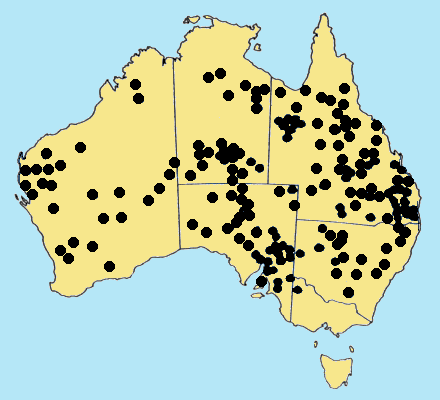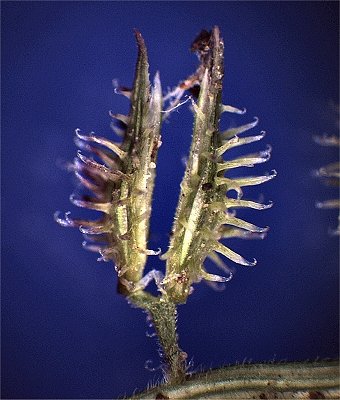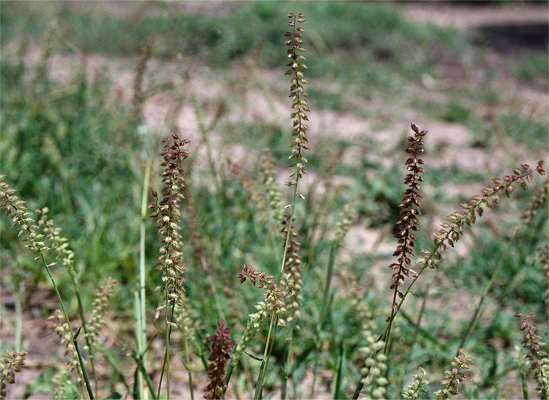Tragus australianus S. T. Blake. Univ.
Queensland Dept. Biol. Pap 1: 12 (1941).
Classification.
(GPWG 2001) : Subfamily Chloridoideae. Cynodonteae.
Type of Basionym or
Protologue Information: Queensland--Maranoa District...Noondoo, near
Dirranbandi, on sand in Callitris forest, also on heavier soils, ca. 550 ft., Blake
10660.
Recent synonyms:
Tragus heptaneron.
Key references
(books and floras): [1878] G.Bentham, Flora Australiensis 7 (506 as Lappago
racemosa), [1952] C.A.Gardner, Flora of Western Australia 1 Gramineae
(185), [1981] M.Lazarides in J.Jessop (ed)., Flora of Central Australia
(470), [2002] D.Sharp & B.K.Simon, AusGrass, Grasses of Australia,
[2006] J.Jessop, G.R.M.Dashorst, F.M.James, Grasses of South Australia
(403), [2008] S.W.L.Jacobs, R.D.B.Walley & D.J.B.Wheeler, Grasses of New
South Wales (386).
Illustrations:
[1952] C.A.Gardner, Flora of Western Australia 1 Gramineae (187,
Pl.54), [1984] N.T.Burbidge. rev. S.W.L.Jacobs, Australian Grasses (259), [2005] K.Mallet (ed.), Flora of
Australia 44B: Poaceae 3 (Fig. 40A-F), [2006] J.Jessop,
G.R.M.Dashorst, F.M.James, Grasses of South Australia (402, Fig. 335), [2008] S.W.L.Jacobs,
R.D.B.Whalley & D.J.B.Wheeler, Grasses of New South Wales, 4th edn
(386).
Habit. Annual
or ephemeral. Culms erect or geniculately ascending or decumbent, 20–43 cm
tall, 2–4 -noded. Ligule a fringed membrane or a fringe of hairs, a ciliolate
membrane, 0.5–1 mm long. Leaf-blades flat, 2–6 cm long, 2.5–6 mm wide.
Inflorescence.
Inflorescence solid, a raceme. Racemes numerous, spreading, oblong, 0.4–0.5 cm
long, bearing 2 fertile spikelets on each. Central inflorescence axis 5–11 cm
long. Rhachis obsolete, deciduous from axis.
Spikelets.
Spikelets sessile. Fertile spikelets 1-flowered, comprising 1 fertile
floret(s), without rachilla extension, lanceolate, terete, 5 mm long.
Glumes. Glumes
firmer than fertile lemma. Lower glume lanceolate, hyaline, 0 -nerved. Upper
glume lanceolate or ovate, 2.9–4.5 mm long, membranous, without keels, 5
-nerved. Upper glume surface with hooked spines, glabrous or indumented.
Florets.
Fertile lemma 2.6–4 mm long, without keel, 3 -nerved. Lemma surface glabrous or
indumented. Palea 2 -nerved, without keels. Lodicules present. Anthers 3. Grain
1.2–2.1 mm long.
Continental
Distribution: Australasia, Pacific, and South America.
Australian
Distribution: Western Australia, Northern Territory, South Australia,
Queensland, New South Wales, Victoria.
Western Australia:
Fitzgerald, Dampier. Carnegie, Giles, Helms, Fortescue, Ashburton, Carnarvon,
Austin. Roe, Avon, Coolgardie. Northern Territory: Victoria River,
Barkly Tableland, Central Australia North, Central Australia South. South
Australia: North-western, Lake Eyre, Nullabor, Gairdner-Torrens Basin,
Flinders Ranges, Eastern, Eyre Peninsula, Northern Lofty, Murray, Yorke
Peninsula. Queensland: Burke, Burnett, Cook, Darling Downs, Gregory
North, Leichhardt, Maranoa, Mitchell, Moreton, North Kennedy, Port Curtis,
South Kennedy, Warrego, Wide Bay, Gregory South. New South Wales: North
Coast, Central Coast, North-Western Slopes, Central-Western Slopes,
North-Western Plains, South-Western Plains, North Far Western Plains. Victoria:
Murray Mallee, Riverina, Volcanic Plain.
Notes.
Widespread throughout the arid and semi-arid areas of mainland Australia, and
near coastal in southern Qld and central W.A. A summer ephemeral occurring on
soils of various textures, but mostly on red sandy soils; in bare open spaces
and disturbed areas, in sparse to dense woodland with such species as Poplar
box (Eucalyptus populnea), Mulga (Acacia aneura), Brigalow (Acacia
harpophylla), Belah (Casuarina cristata), or Callitris spp.,
or other Eucalyptus or Acacia species, or in herb- or grass-lands
dominated by Bassia spp., Astrebla spp. or Aristida spp.






